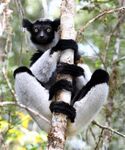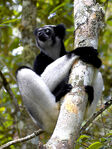The Indri, (Indri indri), is a species of lemur native to Madagascar. It is related to sifakas and is also called the Babakoto.
Etymology[]
The word indri probably comes from the Malagasy word for this animal, Endrina. The most likely incorrect term is that it comes from the term indry, meaning "there" or "there it is".
Appearance[]
The indri resembles most lemurs, but it is the largest. It is 25-28 inches tall with a 5 cm long tail. It's tail is unusually small for a member of the lemur family. Indris have a dense coat of silky black fur with white patches depending on its geographic location. It's fur can also be brown or grey in color. Sometimes, they never lose their black color. Their toes and fingers demonstrate great skill being able to hold up their weight high in the canopy. Their hind legs are very powerful and can launch the indri 32 feet between each branch. It's large yellow eyes have binocular vision that allow it to judge the distance between the branch and itself. It weighs 13-21 lbs.
Behavior[]
Strangely, like humans, indris stay with their mate for a long time, until its mate dies. They live in families much like people, consisting of a male, a female, and their offspring. In more remote regions of their range, indris might live in large families consisting of many generations. It is common for families to move 300-700 meters per day. The time when they travel most is mid-summer when they are in search of good fruit. Though they are social, they will sleep alone or in pairs. They sleep 32-98 feet above the ground. Females seem to be the more playful of the 2 genders. They are often seen playing in the trees for a few seconds or to 15 minutes. Indris mark their territory by urinating or defecating in the places they choose. They are diurnal and have been known to swing through trees at a speed of 20 mph.
Indris give birth every 2-3 years which eventually expands their group. Their gestation is approximately 17-21 weeks. The female primarily cares for their offspring, but the father assists somewhat. Infants are born mostly or solid black, though they might begin to show white fur growth at 4-6 months of age. Infants cling to their mother's stomach until they are 4 or 5 months old. They then proceed to the back, until they might begin to show independence at 8 months. They are never completely independent from their mother until they reach 2 years of age. Sadly, most indri infants are thought to die before 2 years due to sickness or injury.
People are familiar with the indri's interesting calls. They are very distinctive and loud and may last for 45 seconds or for 3 minutes. Usually a roar sequence will take place for several seconds in which all members of the family, except the young, participate. They follow the roar sequence with a long note sequence with which their notes last for 5 seconds in duration. Then, there is the descending phase sequence. Here, two indris form a duet and begin the notes at a high pitch, then progress into a lower. Songs may also represent territorial defense, warning signals, and environmental conditions. They will also start to sing after disturbances like other lemur calls, airplanes, cars, bird calls, and during thunder and lightning. Families sing 7 times daily with their peak singing hours being at 7-11 A.M. Indris have been known to climb at the top of trees in order to amplify their song so it can be heard for 3-4 kilometers away.
Indris engage in an action frequently referred to as sun-bathing or sun-worshiping. As the sun rises each morning, the indri will sit on a branch facing the sun with it's legs crossed, it's back vertical, it's hands resting on it's knees, and eyes half-closed. Malagasy people believe this action is a demonstration of worship. They assume indris worship the sun. Anthropologists have not fully determined what this action is, but argues that it is sun worship.
Diet[]
It eats fruits, seeds, flowers, and primarily freshly sprouted leaves. It will pull a branch closer to it's mouth using it's hands and then pluck the food off of the branch using it's teeth.
Predators[]
Hawks, snakes, and fossas are their main predators. They are known to have different calls based on which type of prey it is.
Lifespan[]
Most live for 15-18 years, but some have reached 22.
Local Mythology[]
The indri is said to be protected by a taboo, or the prohibition an action based on it being sacred. There are countless myths about indri's origins, but either way it is considered a sacred being, not to be harmed in any way.
One origin myth establishes a much closer connection between human beings and indris. In some regions, it was believed that 2 brothers lived in a forest together. One left to cultivate the land, while the other chose to dwell in the forest. The one that left became the person, the one that stayed became the indri. Another origin story consisted of a man who went into the forest to hunt, but did not return. His absence frightened his son, who went back into the same forest that his father disappeared into. The son did not return. Close villagers became worried and went to search for their missing people. They only saw 2 large lemurs sitting in a tree. The father and son had turned into the first indris. Other versions say that only the son disappeared and transformed into an indri. The wailing of the babakoto is the son begging for his father. According to one myth, a young boy entered into a forest to collect honey, but was stung by bees in the process. Stunned by the pain, he fell from the tree, from which an indri caught him and carried him to safety.
Conservation[]
The indri is an endangered species. It's population decreases due to habitat loss and hunting. This destruction still occurs in protected areas.
The indri is still widely hunted even due to the myth of it being a sacred animal and being protected under a taboo. People whose taboo prevents them from eating the indri will still hunt the creatures and sell their flesh. Those whose taboo forbid them from killing the indri will still purchase and feast on their flesh, as their meat is a prized delicacy in some regions.
Sadly, only a single individual lived for barely over a year in captivity, and was not successfully bred. There are still 10,000 specimens in the wild, but some sources say under 1,000. Still, the biggest worry to science is that it has not been bred in captivity.
Gallery[]
Video[]
Facts[]
- Before deforestation happened, indris were incredibly common in Eastern Madagascar.
- The colors of indris differs based on geographical location, individuals in more Southern areas have more white, while ones in the more Northern areas are much darker.
- It is the largest species of lemur.









